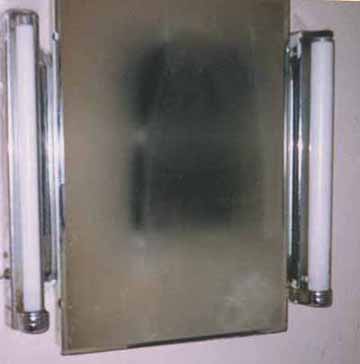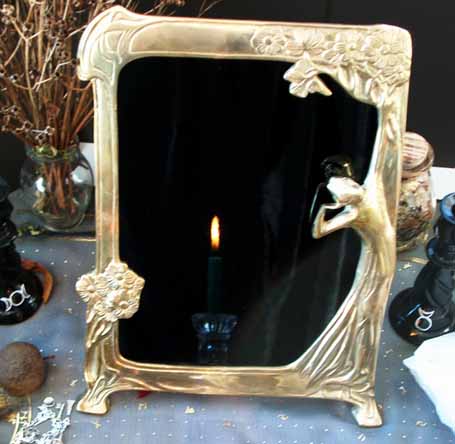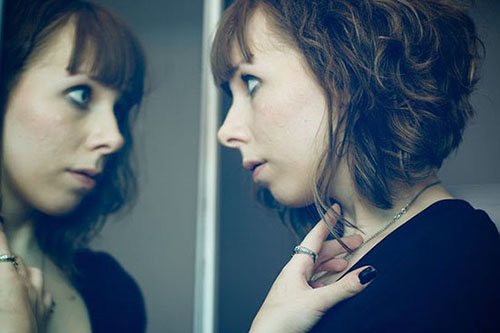

Mirrors that are steamed up can leave messages or impressions from the other side. Mirrors can serve as 'windows' to other realities. Mirror images manifests all at once as they come from consciousness.
Exercise 1:
An entire picture, or part of something can manifest. Observe the mirror from various angles. You may be surprised at what you see! Messages and symbols received are subject to personal interpretation.
Exercise 2:
You an also do this with a candle held beneath your face, but not too close. The candle holder must have a large base to capture the wax drippings as they fall.

Magic mirrors were allegedly used in ancient times to see the future.
In Persia the Magi used mirrors.
In the East they were called Stellar Mirrors.
In Rome people who read mirrors were called Specularii. Pica della Mirandola had faith in them providing they were made under a favorable constellation, and that they should only be consulted when one felt comfortably warm, for the cold harms the lucidity of their oracle.
The Chinese and the Hindus made their mirrors out of metal - their shapes concave or convex.
Some bore the name of their inventor (Cagliostro, Swedenborg, etc.)
More recently they have been used to fix the eye of clairvoyants or mediums so as to put them into a state of hypnosis.
Cahagnet, in his Magnetic Magic, quotes the principal mirrors as follows:
- The Theurgic Mirror - a bottle of clear water looked at by a child and in which the Archangel Gabriel replies by pictures to his questions.
- The Mirror of the Sorcerers - any kind of mirror or pail of water. The country sorcerer, standing near the consultant, recites a spell and shows him the reflection of the picture wanted.
- The Mirror of Cagliostro - the bottle of clear water is on a piece of furniture, and before it a child, on whose head the operator places one hand and tells him the questions to ask, to which replies are given in allegorical pictures.
- The Mirror of du Polet - a piece of cardboard having pasted on one side a sheet of tin and on the other a piece of black cloth. The operator magnetizes it strongly and places it a foot away from the eye of the consultant who, having fixed his eyes on it, soon sees in it the desired object.
- The Swedenborgian Mirror - a paste of graphite mixed with olive oil is poured on an ordinary mirror and allowed to dry for a few days. The consultant, whose image must not be reflected (he stands at some distance for this reason) looks into it, whilst the operator stares magnetically at the back of his head, and vision takes place.
- The Magnetic Mirror - a round crystal globe filled with magnetized water at which the consultant looks carefully until the desired vision appears.
- The Narcotic Mirror - similar globe but a narcotic powder made of belladonna, henbane, mandragora, hemp, poppy, etc., is dissolved in the water.
- The Galvanic Mirror - it is made of two discs, one of copper and concave, the other of zinc and convex, both magnetized nine times in nine days. The center of the concave is looked at.

Have you stared into a mirror or into somebody's eyes for a period of time and their facial features change? You may have though you've seen yourself in another lifetime or seen someone else looking back at you. This is called the Troxler Effect - an optical illusion affecting visual perception. When one fixates on a particular point for even a short period of time, an unchanging stimulus away from the fixation point will fade away and disappear. Recent research suggests that at least some portion of the perceptual phenomena associated with Troxler's fading occurs in the brain. Read more
Why do we see monsters in the mirror? MNN - August 16, 2017
HereÕs a fun exercise, though you might not want to do it alone. Stare into a mirror for several minutes and you may notice your face begin to distort. It could even morph into something downright scary.
Seeing monsters in mirrors has long been an effective horror movie device and grist for urban legends. It might sound like a bunch of superstitious hooey, but scientific research now says that seeing altered images in a mirror is a real thing, most likely due in part to a type of optical illusion called "peripheral fading" or the Troxler Effect.
The discovery that mirror-gazing leads people to see things comes from Giovanni Caputo at the University of Urbino in Italy. In 2010, he published an article in Perceptions describing his otherworldly research findings. Fifty participants were asked to stare into a mirror for 10 minutes in a dimly lit space. Most of them saw far more than they bargained for. Some 66 percent witnessed huge deformations of their face, 18 percent saw an animal such as a pig or cat, 28 percent observed an unknown person and 48 percent beheld monstrous or fantastical beings.
If you were into ghoulish folklore games like Bloody Mary as a kid, these findings may help explain a few things. No one knows exactly how that slumber-party staple got started, but it involves staring into a mirror in a darkened room and saying Bloody MaryÕs name repeatedly until she appears as a ghost or witch behind you. The idea is to give participants the fright of their lives.
Brain illusions
One possible explanation for CaputoÕs "strange-face illusion" is the Troxler Effect (or TroxlerÕs Fading). In 1804, Swiss philosopher and physician Ignaz Paul Vital Troxler noticed that if someone stared at a fixed point for even a short time, peripheral images started fading away. Experience peripheral fading for yourself by staring at the red dot in the center of the image below. YouÕll notice the blue circle around it soon begins to disappear.
Troxler explained peripheral fading as visual neurons adapting to unimportant stimuli. At first you see everything in front of you, but then your eyes begin to ignore what isnÕt necessary or within their central focus. This presumably frees up processing power and enhances perceptual efficiency.
Peripheral fading also may be at play in your bodyÕs other neural systems. Think of putting on a watch. At first youÕre aware of its weight on your wrist and the cool metal against your skin, but within minutes the sensation has faded. The watch is still there, but you no longer feel it. In the same way you may hear birds singing outside, but as soon as you begin reading your email, the sounds slip out of consciousness.
In the case of the strange-face illusion, as you stare at yourself in a mirror, peripheral areas of your face begin fusing or dissolving like objects in a Salvador Dali painting. Your mouth may stretch to one side, your forehead might meld into your cheeks and your eyebrows may droop to your chin.
Peripheral fading seems to explain the shape-shifting that CaputoÕs research subjects witnessed in their own faces. But what about those who saw fantastical beings, animals and unknown people? The theory doesnÕt fully account for these full-on hallucinations or the sense of otherness some participants felt when staring at them face-to-face. A few even reported beings with malevolent expressions that filled them with fear and anxiety.
Caputo argues that something else may be going on, a form of the "dissociative identity effect." Perhaps the brain scrambles and then actively fills in new facial features (even really scary ones) in ways that science doesnÕt yet understand. So next time you crave a fear fix, forget hair-raising Hollywood blockbusters and frightful fun house rides. All you need is a mirror and your own brain.

MIRROR SCRYING 2
MESSAGES FROM OTHER REALMS INDEX